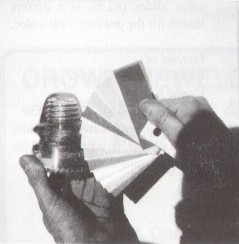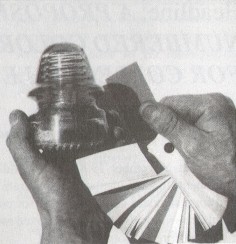Headline: A Proposed Transparent Numbered Color Reference For Collectible Glass
by Mark Lauckner, Mayne Island, British Columbia V0N-2J0
Reprinted from "Crown Jewels of the Wire", May 1991, page 5
In November 1990, after building a spectrograph to study the color components
in glass insulators (a separate article indeed), I realized the incredible need
for a standard color reference for collectible glass. A quick flip through a
recent Crown Jewels of the Wire proved me right... .orangish amber, sca aqua,
kind of emerald green...sound familiar?
Upon completion of a preliminary set of
slides, I consulted with N.I.A. president Eric Halpin on the need and validity of
such a project, and got some encouraging feedback like "several attempts
have been made", and "a project of tremendous merit."
So after
four months of casual development, I took the 30 blue slides to 4 area
collectors, and asked them to point out peacock blue. Each collector pointed to
a different color, and there was immediate disagreement over which was peacock.
I realized that trying to attach common names to the slides was like opening a
big can of worms, HUGE! After a short feeling of despair, I decided to eliminate
all color names, and just leave the comprehensive numbering system attached to
each slide. This will avoid any misunderstandings on accurate description.
The
proposed booklet is 1-1/2 inches by 4 inches and contains 110 color slides
interleaved with 110 paper slips with color numbers and a graph showing the
mixed amounts of color that make up each slide. A velcro/ leather folder
encloses them when not in use.

Making a rough selection on the color.
Color matching with the slides is easy. Simply
fan the slides out in the color range near the specimen, and choose the closest
match. Separating the slide from the others and placing it next to the specimen
in indirect light will show the transmission of light through the specimen and
the slide. If it is not a perfect match, fine tuning may be needed. This is done
by sliding up other samples to add to your first color. Adding slides of the
lighter primary colors will swing it to the right direction, so you will know
which color tones to choose from, if more than one slide is needed for a perfect
match. It is easy to see if your selection needs more yellow, blue, etc.

Fine tuning your color selection
A suggested method of describing color with the system would be to simply add
the number to the end of the common color name. This way, people who are not
interested in an accurate description can accept the common name, and those who
want to see an accurate representation of the color can select the number
slides. This method in no way is intended to replace color names, just aid in
their description.
Proposed method of description:
(prefix CN .. color number)
Instead of
CD 162 H.G.CO., peacock blue
Could be
CD 162 H.G.CO., CN 230 which indicates that one of the color slides
(#230) is a perfect match for the peacock blue color.
Instead of
CD 123 E.C.&M., blue aqua
Could be
CD 123 E.C.&M., CN210/350 which indicated that two color slides (#210
and #350) were needed for a perfect match.

Rough select the slide closest to
the CD 123E.C.&M. --
CN 210 -- a green aqua slide.

Fine tune the E.C.&M. color selection
by introducing light blues to match perfectly.
Final section was slide CN 350
Also included in the booklet will be a diffusion slide for matching milk
glass specimens, a variety of neutral greys for darkening colors, and a number
of color filters for matching under different lighting conditions.
Of course, the success of such a system depends on its quick and wide
acceptance. I can't imagine how we got this far without a standard color
reference to compliment our CD (Consolidated, Design) system.
MARK LAUCKNER
MAYNE ISLAND
BRITISH COLUMBIA V0N-2J0
(604) 539-5937
Editor's Note: An incredible amount of research and thought has gone
into the preparation of this proposed color reference system. I hope that the
readers of Crown Jewels of the Wire will take the time to write or call
Mark regarding his idea.
| 